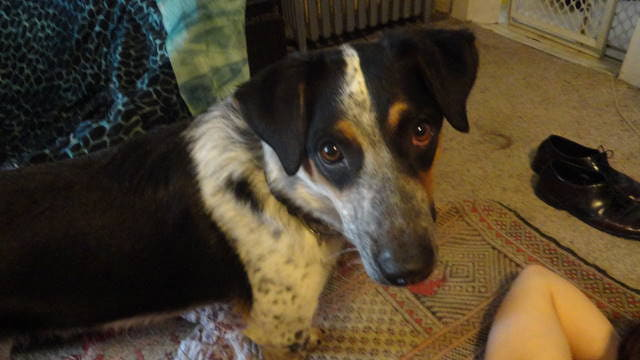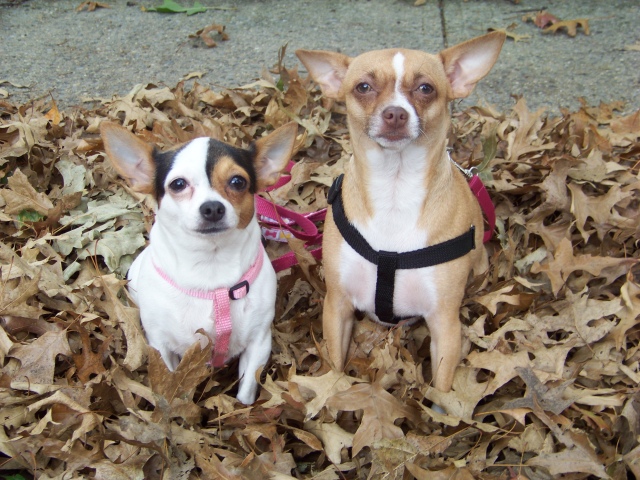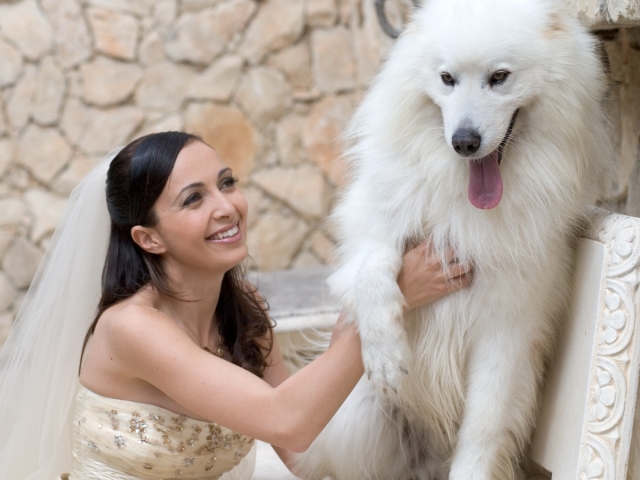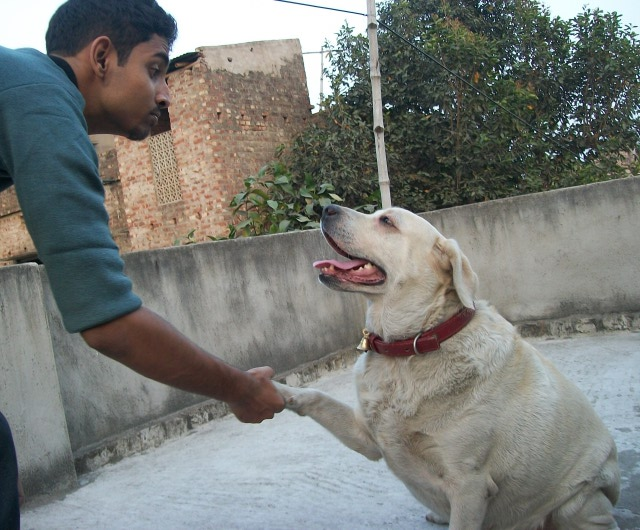QuestionThat's a great idea...You know one time a vet told me that a puppy has a very short memory and if they have an accident in the house only crate them for like a minute for punishment to start. I want to tell you something that happened 3 days ago, I was letting Ginger in the back door where she has a zip tie type run so she has almost the whole yard to play, and she loves the snow...I was in a hurry to leave and wanted to let her out before I left for a doctors appt. I was dressed in my warm clothes and ready to go, I even had my purse on my shoulder. When I was letting her in she can walk into the kitchen and I shut the door before I unchain her. When I was unhooking her in the kitchen and I bent over, my purse was on my back and it swung down and kinda bumped her and it of course scared the crap out of her, and guess what, the past two and a half days I literally had to go put my boots on and coach her into the house and her tail was between her legs while I was unhooking her, so much for dogs forgetting so easily, now she is scared to come in the house unless I coach her with food...either I chase her down and scootch her in the door with her scared to death or drop some food on the kitchen floor and she will come in to eat it, being not so scared. I do not want to over treat her although I buy good treats, and sometimes use a squeaker from an old toy and they makes her come running instead of food, but they catch on to that trick pretty quick too...Ginger does not seem to have any hearing, or sight issues from what I can tell, she has never ran into anything oddly, and she can hear me call her from a mile away, now whether she listens is another story, But, she was only 8 weeks old when I bought her and I swear the people cried when I took her, so I do not believe they abused her, but I do think she is the runt of the litter because she is 1 yr old and only weighs 42.15 lbs. I just had her spayed...that is why and she is much smaller than my other Lab Shadow...I spoil her just like a kid. I guess I am comparing her to my other lab way too much but, I have done so to try to figure out why she is so nervous, maybe her mother or the pups have something to do with it? She don't even like water, I feel as if I have a defective Lab...I bought her a pool and she avoids it.I just don't understand her, if I make the smallest noise of opening some kind of food package and she thinks she will get a treat she will come running, but if I am opening up like my plastic cover on my insulin, it's like she knows the difference, so she is not stupid. I am a high anxiety person and I thought she picked up my senses of anxiety but, I live alone and I don't yell or anything, I am very quiet and easy going. I will take her to the vet but, I don't want her medicated for anxiety because I know that kind of medication makes you lethargic. Do you think my personal problems or Anxiety attacks could have rubbed off on her? So my new question to you, is What kind of memory do you think a dog has? I mean they remember sit, stay, speak, come, car, etc. Thank you for your reply. Sincerely, Michelle Fitch
AnswerHello Michelle:
You can have a dog that is just naturally nervous, it would be the result of temperament.
There are things you can do to help.
Rescue Remedy is a Bach Flower Remedy, that is all natural product and can be found in Health Food Stores and some pharmacies.
People have had a lot of success with Thunder Vests.
Continue the desensitization of things that make her nervous and work them one thing at a time.
Below is a document I give out to my clients with similar issues as a reference tool.
Fear: How to Help Your Dog Overcome It
Dogs can develop fear of any person, place or thing. Considering that the same thing happens in humans, this isn't surprising.
Dogs inherit their temperaments from the dogs who make up the family tree. A confident mom and dad don't guarantee confident offspring, though, since dogs further back in the bloodline may have planted genetic surprises that hide for a generation or even a few generations. Dogs have less reasoning ability to overcome their "hardwired" genetic behaviors than humans do, so a poor genetic temperament can be difficult or even impossible to overcome.
Physical health plays a major role in dog temperament, too. Unable to explain that something hurts, a dog will try to avoid that painful situation. Some dogs do this by moving away if they are free to do so, but these dogs as well as the more assertive types may react aggressively to ward off something they know from experience is going to hurt. With any fearful or aggressive dog behavior, medical issues are the first thing to consider.
Once a dog has begun to react with fear, correcting the original trigger of the behavior is not always enough to change the dog's habit of reacting that way. The earlier you intervene, the better your chances of relieving the fear. Recovery is faster when you start rehabilitating the fear sooner. In fact if you work through it immediately after the scary event happens, you may be able to alleviate the fear in just one session. In such a case you're dealing with a first impression rather than an established fear.
Don't count on this quick fix, though. Be prepared to continue helping the dog at a pace comfortable over the long haul for as long as it takes. Your patience and willingness to work through tiny steps will in and of itself take pressure off the dog and speed the process. Slower is literally faster when it comes to this type of work with your dog.
Prevention
Puppies who have the right early life experiences have the best chance of developing confident personalities that cope well with life and have the ability to bounce back from stresses. The temperament the puppy inherits from its ancestors will always be a limiting factor on just how healthy the personality can be. But the right handling will make the most of whatever strengths are there, and help to limit the problems from the dog's inherent temperament weaknesses.
Providing a puppy with the right early experiences is more complicated than it seems. Puppies can stoically endure events in their lives, apparently be fine, and then show serious fear reactions from those events as their defense drives emerge with maturity.
Yet keeping a puppy protected from any potential fear or stress doesn't work, either. Part of growing up to become confident is learning that scary things can have happy endings. Another part is learning that you can overcome something scary. On the other hand, puppies can get carried away in the enjoyment of overcoming and become aggressors.
Puppies who have too little stress in early life can grow up lacking the ability to handle stress. Puppies who have no frustrations can grow up unable to cope with frustration, and unable to take "no" for an answer. This can happen to pups who grow up in one-puppy litters with no littermates to compete with, and to pups removed from the mother dog prior to 8 weeks of age.
Into every life, no matter how adorable, a little rain must fall. Otherwise the pup will not be equipped to cope with the inevitable storms of later life. This is not only tough on the people and other dogs who will have to cope with this dog later, but it can also set the dog up for stress and unhappiness in life. The right experiences give your pup the best chance of a full and happy life.
Puppy classes have saved many a puppy and family from dire problems later. A good class will help the family find the right balance of taking the puppy out for positive experiences and setting limits for the puppy. Class can also teach the family the dog-handling and management skills to make it all work.
Puppies seem deceptively easy to rear. It's actually a sophisticated and potentially exhausting job to properly raise a puppy. The breed of dog is a factor in the degree of difficulty, as is the care that has been taken by the breeder. Good genetic decisions about the dogs in the bloodline combined with excellent handling in the puppy's earliest weeks are both critical factors in the dog your puppy will become.
For people not equipped or interested in raising puppies, plenty of dogs who are past this difficult and uncertain life stage need homes. Instead of "inheriting someone else's problems," as some tend to view adopting adult dogs, you are quite likely to find yourself blessed by the love and care someone has invested in the dog's early months. Either way, the dog's personality is much more evident and testable than is the future personality of a puppy.
Common Fears
Several things seem to haunt the minds of a great many fearful dogs. Let's look at some of these, why they may develop, and hints for working through them.
Vacuum Cleaners and other Household Appliances
Vacuum cleaners make weird noises. Their use involves a person thrusting the thing around the room in gestures that wouldn't make any sense to a dog. The concept of cleaning a floor, other than by eating any food spilled on it, would also be foreign to a dog's way of thinking. There's not much about a vacuum cleaner for a dog to like! The occasional herding dog will chase it because it moves, and some dogs will "attack" or threaten it because it isn't acting right!
Adding treats to vacuuming time can work through this fear. If the dog is really traumatized about the device, you may need to start with setting up the vacuum cleaner and giving the dog treats in the next room. Over several sessions you can move the treat-giving closer, never faster than the dog's comfort level can handle. Do the process with the vacuum off, next with the vacuum cleaner running, and finally with the vacuum cleaner moving. While going through this program, put the dog in a different place whenever you vacuum so as not to undo all the good conditioning by scaring the dog again.
To condition your dog to appliances that merely make noise without lunging around the room, use the same process. For these appliances as well as the vacuum, you can use not only treats, but also meal times (place the dog's dish increasingly closer to the scary thing, a little closer with each meal) and games. Dogs who like to fetch have a real advantage, because retrieving is so motivating to dogs.
The dishwasher is an interesting case. Dishwashers that open with a big movement can cause dogs to dash out of the room. But if your dog likes to try to sneak a lick off a dirty dish when you open the dishwasher, there's a built-in treat. Some of these enterprising dogs love dishwashers. That makes it your job to avoid hurting the dog with the dishwasher door, or letting the dog eat spoiled food. Dishwasher soap can be toxic.
The dishwasher would be a case for teaching the dog to calmly remain in the room but back from danger. Reward the dog for keeping his head OUT of the dishwasher!
Lawnmower
For similar reasons to the fear of vacuum cleaners, some dogs are afraid of lawnmowers. This seems to be less common, probably because we use lawnmowers in the open air, not in enclosed spaces where dogs feel trapped and the noise reverberates off the walls like the vacuum cleaner. There are dogs who run from lawn mowers, though, and even worse, dogs who will try to "attack" a lawnmower. Running lawnmowers are extremely dangerous to dogs. Always remove your dog from the yard being mowed and keep the dog in a safe place until the lawnmower is turned off.
Slippery Floors
Fear of walking on vinyl or other smooth floors is common. Fear begets more fear in this case, because when the dog slips even more from tensing up and trying to hold tight to the floor with toenails. Sometimes the events that trigger these fears are invisible to the human eye. A puppy slips and hits her chin on the floor, hard. Other parts of the body can take similar licks when feet slip. Dogs seem to have trouble at times managing all four feet at once. Unless they develop the skill for some reason-such as special training or games-they may find it awkward to walk backwards or to get their feet under control when one or more feet slip.
For dogs with orthopedic problems including hip dysplasia, walking on smooth floors can be painful. Make physical changes to aid these dogs. You can put rubber-backed rugs across the floor as a pathway for the dog. If the slick floor is not at your home but rather is someplace you're visiting, you could either carry the dog or transport the dog across that floor on wheels.
If you know the fear is not based in a physical problem, use mealtimes to work through it. Mealtimes are opportunities to work on fears of slick floors that you know are not based in physical problems. Place the dish in a spot relative to the smooth floor where the dog seems comfortable. Meal by meal, gradually move the dish further and further into the room with the smooth floor.
Continuing to feed the dog on this floor-provided it doesn't hurt the dog to walk on it-can help maintain the dog's ability to cope with smooth floors. Be alert, though, for changes in the dog's body that mean it is no longer humane to ask the dog to walk on this floor. Most dogs develop orthopedic problems as they age, and injuries that cause these problems are extremely common at younger ages, too. At that point, add a rug walkway for the dog.
In situations where a dog walking on a smooth floor is unavoidable, look at possibilities for making the feet grip better or making the floor less slick. The way the floor is cleaned and treated makes a difference, and you'll also want to promptly clean up any fluids spilled on the floor. Various things have been tried for making the feet grip better. Discuss safe options with your veterinarian. Dog show enthusiasts suggest creating a puddle of sugary soda pop on the floor and wetting the dog's feet in it to make them sticky!
Sights and Sounds
Some dogs react fearfully to something that looks strange. Others are more reactive to things that sound strange. Sensitivities from one dog to another are largely rooted in the huge differences in how different dogs actually perceive the world. Dogs have been bred for such different tasks that their bodies are quite different from one another. Paying attention to your dog's reactions will help you learn what kinds of things are likely to cause your dog to react. Whatever the fear, the principles outlined below will help you work through it.
People
When a dog reacts fearfully to a man, people tend to jump to the conclusion that a man has abused the dog in the past. Possibly that is the case, but often it's a problem of lack of early social experience with men. Men, women, children, people wearing big hats, people in Halloween costumes and a wide variety of other human presentations can spook dogs who have not experienced that "style" of person before.
Of course, if there has been actual abuse or something has happened to frighten the dog in conjunction with that type of human, the dog's fears will go deeper. Either way, the treatment is basically the same. Don't let people force themselves on a fearful dog. In spite of hurt feelings on the part of the offended human, this process needs to be taken just as slowly as when dealing with any other fear.
Working Principles
With a severe fear that causes the dog to suffer, you need to enlist the help of a canine behavior specialist who can prescribe both the behavior modification protocol to deal with the fear as well as suggest any indicated medication. When the fear places people in danger because the dog reacts aggressively, that's another case and again a specialist in canine behaviour will be the person to help.
Similarly, get help quickly with an extremely fearful puppy. The right intervention can do so much more for a puppy during early development than if you let this opportunity pass and the habit of fear to become stronger with time.
Whether working on your own or with the help of a specialist, the following principles are typically part of working through a dog's fear:
1. Have a veterinarian examine the dog and perform any indicated tests to diagnose problems that could be causing pain, sickness or disability. Work with the veterinarian to treat the problem and ease the dog's physical pain. Bring the dog back to the veterinarian regularly.
Don't assume that a problem brought under control at one point will never need further treatment. Make any indicated changes in treatment to keep the dog comfortable.
This requires detective work! Dogs have a survival instinct to hide their pain, because an animal showing weakness in the wild gets killed. Look hard for possible physical problems, rather than expecting the dog to cry out in pain or otherwise "tell you."
2. Assess the problem:
a. Do you know of an event that started the fear?
b. Is the thing the dog fears actually dangerous and/or likely to cause pain to the dog? How are you going to keep your dog safe?
c. Are people or other animals being placed in danger by the dog's behavior and if so, how are you going to put a stop to that danger right now?
d. How can you protect the dog from experiencing this fear while you work through the behavior modification steps?
e. Is it necessary for the dog to cope with this situation, or could things reasonably be managed to simply keep the dog away from it from now on?
f. If you determine it's better to protect your dog from this situation rather than trying to treat the fear, give the dog time to get used to your new plan. Chances are you'll be surprised to see how much happier your dog becomes.
3. To treat the fear, plan the steps for conditioning your dog gradually to the feared thing. Plan how you are going to start at a DISTANCE from the feared thing, with it functioning at a low INTENSITY for periods of short DURATION. Plan how you will, over time, gradually reduce the distance, increase the intensity, and expose the dog to the feared thing for periods of longer duration. Plan how you will increase one variable at a time.
4. Determine what things this dog finds rewarding. For the greatest chance of success, you'll want to use as many of them as possible. Incentives include: food treats the dog likes, food treats the dog goes crazy for, regular meals, retrieving, games with you the dog enjoys playing, special toys reserved for special times, "happy-timing" the dog with a jolly attitude (using excited voice and body language to convey to the dog that is a happy thing), privileges such as a walk or ride in the car, and anything else THIS dog likes.
If you can't come up with anything your dog finds rewarding, developing these motivators is your first training goal! You may need the help of a behavior specialist or trainer. One option is to break the dog's daily food into more, smaller meals. Some or even all of the food can be fed by hand, depending on what works best for your conditioning program.
5. Discontinue all exposure of the dog to the feared thing. Start your conditioning program at the distance, intensity and duration where your dog happily accepts rewards. Advance very slowly toward your goal of having the dog comfortable with the feared thing so that the dog will be able to function happily around it in the future. Be patient and take as long as needed to avoid pushing the dog too fast. If you trigger the dog's fear during this process, that's a big setback, so keep the progress slow enough to avoid that.
6. Reward your dog at times the dog is showing confidence. Avoid rewarding fearfulness. Certainly don't punish the dog for acting fearful! Just give the rewards at the moments when you see in your dog the state of mind that is your goal.
It Works!
Chances are good that at some point with every dog you'll have the opportunity help the dog overcome a fear. Some dogs go through most of their lives with barely an apprehensive moment, and then get hit hard in old age when their bodies begin to fail and they don't know how to cope. Now you know how to help your dog develop the ability to cope, at any age.

 A doting mother in need of help!
Question
Chewy
In the past year I got a cattle d
A doting mother in need of help!
Question
Chewy
In the past year I got a cattle d
 My dog eats poop
Question
thats luna to the righ
Hello, how are you? I h
My dog eats poop
Question
thats luna to the righ
Hello, how are you? I h
 7 yr old Samoed seriously regressing in toilet training
Question
My wife and "Kid"
7 yr old male samo
7 yr old Samoed seriously regressing in toilet training
Question
My wife and "Kid"
7 yr old male samo
 5 yr old lab fetch problem!
Question
handshake
Hello.I am Rameez from India
5 yr old lab fetch problem!
Question
handshake
Hello.I am Rameez from India
 breed identification
QuestionMaggie
QUESTION: Hello - Ive hopped over
breed identification
QuestionMaggie
QUESTION: Hello - Ive hopped over